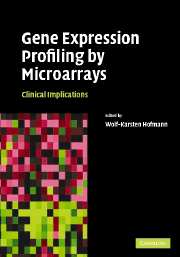Book contents
- Frontmatter
- Contents
- List of contributors
- Foreword
- Introduction
- 1 Technique of microarrays: microarray platforms
- 2 Quantitative quality control of microarray experiments: toward accurate gene expression measurements
- 3 Statistical analysis of gene expression data
- 4 Genomic stratification in patients with heart failure
- 5 Gene expression profiling for the diagnosis of acute leukemias
- 6 Gene expression profiling can distinguish tumor subclasses of breast carcinomas
- 7 Gene expression profiling in lymphoid malignancies
- 8 mRNA profiling of pancreatic beta-cells: investigating mechanisms of diabetes
- 9 Prediction of response and resistance to treatment by gene expression profiling
- Index
- References
2 - Quantitative quality control of microarray experiments: toward accurate gene expression measurements
Published online by Cambridge University Press: 05 September 2009
- Frontmatter
- Contents
- List of contributors
- Foreword
- Introduction
- 1 Technique of microarrays: microarray platforms
- 2 Quantitative quality control of microarray experiments: toward accurate gene expression measurements
- 3 Statistical analysis of gene expression data
- 4 Genomic stratification in patients with heart failure
- 5 Gene expression profiling for the diagnosis of acute leukemias
- 6 Gene expression profiling can distinguish tumor subclasses of breast carcinomas
- 7 Gene expression profiling in lymphoid malignancies
- 8 mRNA profiling of pancreatic beta-cells: investigating mechanisms of diabetes
- 9 Prediction of response and resistance to treatment by gene expression profiling
- Index
- References
Summary
Introduction
Since its introduction in the 1990s, microarray technology has brought about a fundamental transformation in laboratory research, and has become a widely used genetic tool [1]. The technology has great potential in the study of networks that regulate gene expression and in the study of complex human diseases where a comprehensive evaluation is needed. However, as it stands now, acquiring high quality microarray data is still a challenge for many laboratories. The noise and data variability is often high, while correlations with other platforms including RT-PCR and Northern blots, and between different microarray platforms, are often unsatisfactory [2]. As a result, gene expression analysis using microarrays is considered by many to be not quantitative. This has limited the technology's application largely to complex biological systems [3].
The major reason for the noise in microarrays is that there are many experimental steps and hence many sources for data variability. To efficiently reduce the noise in the system, it is essential to have an information acquisition and analysis procedure that can properly dissect the sources and manage each of them accordingly. We have previously reported a microarray hybridization image processing software Matarray, which possesses an iterative procedure that utilizes both spatial and intensity information for signal identification [4]. Most uniquely, a set of quality scores are defined, which measure and quality control (QC) the major sources of data variability including, high and non-uniform noise profile, low or saturated signal intensity, and irregular spot size and shape.
- Type
- Chapter
- Information
- Gene Expression Profiling by MicroarraysClinical Implications, pp. 27 - 46Publisher: Cambridge University PressPrint publication year: 2006



